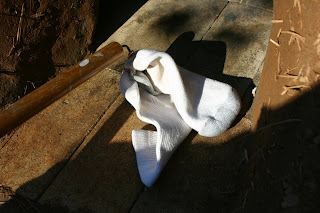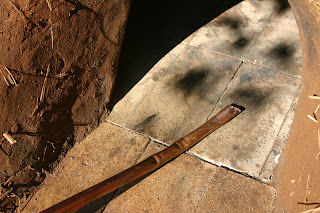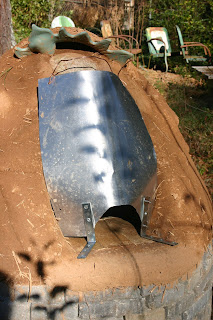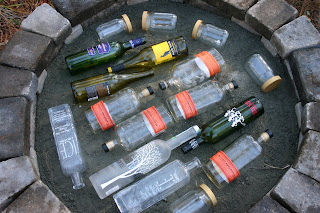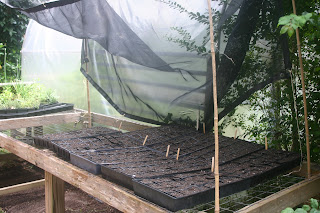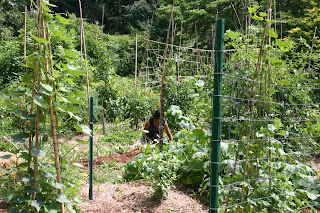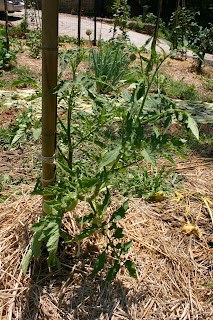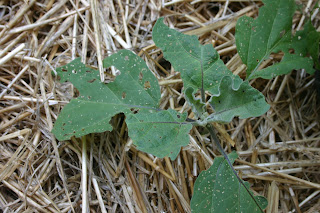
Our production record keeping cycle runs from June 1st through May 31st. With 11 days to go we have increased our production from 1600 lbs. last year to 2600 lbs. this year. We grew an additional 1/2 ton of food, a 62.5% increase, on our little 1/8th acre micro-farm. We are very proud of that accomplishment. The total does not include the eggs our hens produced or the wild mushrooms we harvested throughout the year.
This year we have set a goal to increase our production to 4000 lbs. , 2 tons, a 53% increase. How will we accomplish that?
Maintaining the Soil Food WebOver the past year we doubled the amount of stable humus in our soils. We accomplish this using 3 techniques:
- When crops are finished we cut the tops off at the ground level leaving the roots to feed the microorganisms in the soil.
- We leave as much crop residue as possible to break down right in the beds. This cuts out the extra step of having to compost it too.
- We maintain a mulch layer of either straw or leaves on the beds at all times. The mulch is slowly broken down to supply nutrients to the plants and add organic matter to the soil. The mulch also keeps the soil from drying out and makes great habitat for the shredders like pill bugs, ear wigs and millipedes as well as earthworms and spiders. You can dig anywhere in the garden now and find lots of earthworms.

We are continuing our soil testing and remineralization program. This is the single most important thing we do. We want to provide our plants with all of the nutrients they need in the right proportions to maximize production and to ensure that we are growing the most nutrient dense, health-giving, nourishing food we can for ourselves and our customers.
Sequencing and Crop RotationsWe are refining our crop sequencing to be sure we get the most production out of each bed. This spring we started many more plants in pots and got them in the ground as early as possible. We started a second round last week, mostly winter squashes. Next week we will start our corn to take the place of the potatoes that will be harvested in about a month. Then we are going to experiment with a second crop of zucchini and cucumbers which we will start in July to go in the ground in August.
Last fall we planted all of our greens at the same time. The thinking was that they would be mature by November or so and we would be able to harvest through the winter. Well our winter was much colder than usual so even with row covers we lost much of the crop. We did learn which varieties are more cold hardy than others, a good thing to know. This fall we plant to space
our plantings out. We will direct sow the earlier greens and start others in pots to be planted in November and even into December. The younger plants seem to survive the cold better. I know that seems odd but our experience and that of our friend Steve proves it to be true.
We will grow fewer beds of greens and more carrots, turnips and beets. We have learned how much greens we are able to sell through the winter, We want to have more variety available to our customers.
 Maximizing our Space
Maximizing our SpaceIf it is a vine it is going to grow up. Beans, cucumbers, squashes and tomatoes all grow on fences or bamboo towers with lower plants like peppers, bush beans, eggplants, basil, dill and flowers planted around and among them. In addition to getting more food per square foot this method helps with pest control by bringing in more pollinators, predatory insects and confuses the pests making it harder for them to find their targets.
We are growing in containers for the first time. We have some big pots left from our garden center days that we filled with a nice soil mix and planted with eggplants. The eggplants love warm soil and can tolerate drier soils that some other crops. They are doing much better so far than those planted in the ground which are getting eaten up by those dang flea beetles.

Expanding Perennial Food ProducersWe continue to expand our perennial crops including sunchokes, berries, leeks and fruit trees into spaces not suitable for vegetable production. We are starting to get harvests from the trees and bushes we have planted over the past several years. Our single nanking cherry produced over 10 lbs. of fruit this spring. Our blueberries are producing a small crop this year. We added a second row of blackberries and doubled our sunchoke plantings. Our apple trees have a few fruits on them this year. We might get a few if we are lucky. In the fall we plan to plant some Asian persimmons, pears and a grape vine.
With the help of our 3 new interns, Deanna, Frances and Catherine (who are doing a great job so far) we can make this happen!
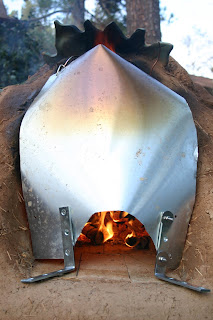

 oven, i mean, bake loaves of bread. This suggests that the abundant thermal mass in this oven will retain heat for a long time once it finally reaches maximum temperature.
oven, i mean, bake loaves of bread. This suggests that the abundant thermal mass in this oven will retain heat for a long time once it finally reaches maximum temperature. While we did have to finish the pizza and calzone for a few minutes in the oven, they tasted great. Smokey, with a nice bottom crust. I look forward to the next time we get to fire her up!
While we did have to finish the pizza and calzone for a few minutes in the oven, they tasted great. Smokey, with a nice bottom crust. I look forward to the next time we get to fire her up!



